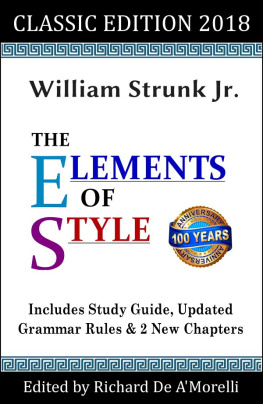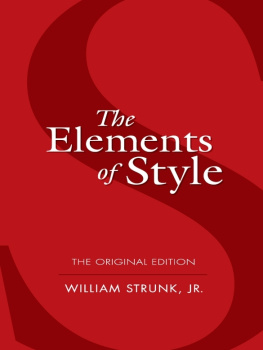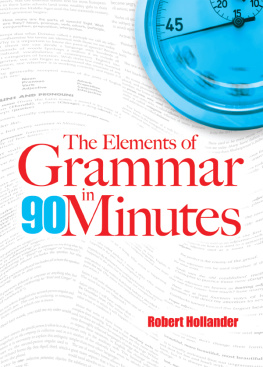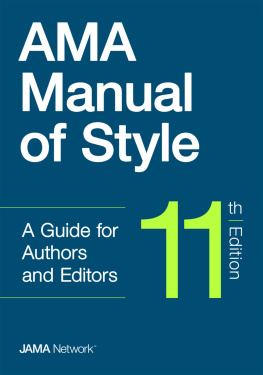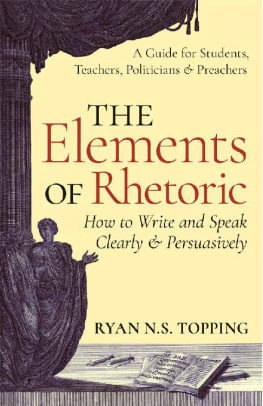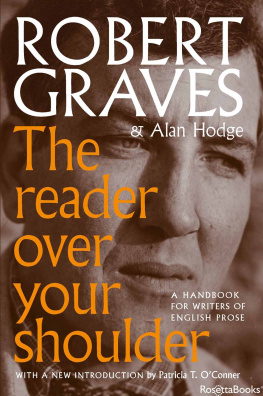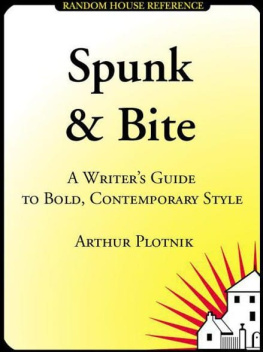William Strunk - The Elements of Style: & : With Editors Notes, New Chapters & Study Guide
Here you can read online William Strunk - The Elements of Style: & : With Editors Notes, New Chapters & Study Guide full text of the book (entire story) in english for free. Download pdf and epub, get meaning, cover and reviews about this ebook. year: 2018, genre: Children. Description of the work, (preface) as well as reviews are available. Best literature library LitArk.com created for fans of good reading and offers a wide selection of genres:
Romance novel
Science fiction
Adventure
Detective
Science
History
Home and family
Prose
Art
Politics
Computer
Non-fiction
Religion
Business
Children
Humor
Choose a favorite category and find really read worthwhile books. Enjoy immersion in the world of imagination, feel the emotions of the characters or learn something new for yourself, make an fascinating discovery.
- Book:The Elements of Style: & : With Editors Notes, New Chapters & Study Guide
- Author:
- Genre:
- Year:2018
- Rating:4 / 5
- Favourites:Add to favourites
- Your mark:
- 80
- 1
- 2
- 3
- 4
- 5
The Elements of Style: & : With Editors Notes, New Chapters & Study Guide: summary, description and annotation
We offer to read an annotation, description, summary or preface (depends on what the author of the book "The Elements of Style: & : With Editors Notes, New Chapters & Study Guide" wrote himself). If you haven't found the necessary information about the book — write in the comments, we will try to find it.
The Elements of Style: & : With Editors Notes, New Chapters & Study Guide — read online for free the complete book (whole text) full work
Below is the text of the book, divided by pages. System saving the place of the last page read, allows you to conveniently read the book "The Elements of Style: & : With Editors Notes, New Chapters & Study Guide" online for free, without having to search again every time where you left off. Put a bookmark, and you can go to the page where you finished reading at any time.
Font size:
Interval:
Bookmark:
THE
ELEMENTS OF STYLE
By William Strunk Jr.
CLASSIC EDITION
2018 UPDATE
Richard De AMorelli, Editor
SPECTRUM INK PUBLISHING
Table of Contents
The Elements of Style: Classic Edition (2018)
Copyright 2018 by Spectrum Ink Publishing.
Published simultaneously in Canada and the United States.
First Edition: July 23, 2018
This volume is a revised, restyled, and expanded update of a public domain work, constituting a derivative edition protected by copyright under U.S., Canadian and international laws and treaties. Revisions to the original work, notations throughout this volume by the editor, and new content added, including new chapters, as well as design elements and typography, are original creative works and protected by copyright. No part of this book may be reproduced, uploaded, shared, or otherwise posted on any blog, website, social network or other medium, digital or otherwise, without the publishers express consent, except for brief quotations embodied in critical articles and reviews.
ISBN Numbers:
978-1-64399-000-2 | Paperback |
978-1-64399-001-9 | Mobi /Kindle |
978-1-64399-002-6 | EPUB |
978-1-64399-003-3 | Paperback (Ingram) |
978-1-64399-004-0 | Hardcover |
Spectrum Ink Canada
Vancouver, British Columbia
Spectrum Ink USA
San Luis Obispo, California
Website:
http://spectrum.org/books
The Elements of Style was written in 1918 by William Strunk Jr., an English professor at Cornell University. He distributed it as a handout listing basic grammar tips for students in his English classes, and he probably never imagined that it still would be widely read a century later. Strunks legacy endured, and his book has helped generations of college students and writers learn the basics of English grammar. Elements of Style was recognized as one of the 100 most influential books written in English by Time in 2011; and author Stephen King recommended it as must reading for all aspiring writers.
In a preface to the first edition, Strunk wrote: This book aims to describe in just a few pages the principal requirements of plain English style. Its goal is to lighten the task of instructors and students by concentrating on a few essentials, the rules of usage, and principles of composition most commonly violated. To fulfill these criteria, the book will describe three rules for the use of the comma, rather than a dozen or more, and one for the use of the semicolon, in the belief that these four rules will provide for most of the punctuation that is required by nineteen sentences out of twenty. Likewise, the book discusses only those principles pertaining to the paragraph and the sentence of the widest application. Thus, we will endeavor to cover only a small portion of the field of English grammar and style.
This Classic Edition is a centennial tribute to Strunk's book, which is not only a useful grammar primer but a nostalgic link to a fabled time in American history that brought the Art Deco era and the Roaring Twenties. Many of the grammar rules in these pages are as valid today as they were a century ago; but, the world has changed, and the English language has changed with it, making some of Strunks rules obsolete. This edition contains the full text of The Elements of Style , plus numerous enhancements not found in other public domain versions of Strunks book, including:
1. Editors notes have been inserted throughout to flag grammar rules now considered obsolete, and to provide up-to-date usage rules for students and writers.
2. Emojis have been added to most examples to help readers easily identify correctly written passages from errors.
3. A Study Guide is included in the last chapter.
4. The paperback version includes blank, lined pages at the back of the book for convenient notetaking.
5. The e-book version has been restyled for improved display on the latest generations of digital reader devices.
In addition, this expanded update features a new Introduction and two new chapters: Basic Rules of Capitalization (Chapter 3) presents an in-depth list of capitalization rules that confuse many writers; and, Style Rules for Better Writing (Chapter 7) offers a collection of tips on how to improve your writing, as well as grammar and style mistakes to avoid when revising and self-editing your work.
Prof. Strunks book stresses the importance of writing clear and grammatically correct prose. It is a blueprint that students and writers can follow to write their thoughts and ideas in a crisp, concise, and effective manner. The clearer your writing, the more likely it is that readers will grasp the points you are trying to make.
If you need a more comprehensive handbook on grammar and style, you may find Elements of Style 2017 useful. Intended for college students, writers, editors, and anyone else who is called upon to write grammar-perfect final drafts, this handy guide builds on Strunks fundamental rules and includes more than 500 grammar and style rules from authoritative sources. Elements of Style 2017 is available in e-book and paperback editions at your favorite bookstore or it can be purchased online at: https://amazon.com/dp/B01MD0396I
Now, lets begin reading Strunks Elements of Style and take the first step toward correct and effective writing.
By Joseph Devlin, M.A.
T o write correctly and effectively, the fundamental principles of English grammar must be mastered. No matter how badly you want to write, no matter how deep your feelings, and no matter how exciting the ideas you want to share with others, if you dont know the basic rules of how to correctly form sentences and the relation of words to one another, your writing will lack coherency. Imagine for a moment a novel with a sensational idea, unforgettable characters, set in an exotic place, and chock full of suspenseno matter how great the idea might be, if the story is penned by a writer who lacks a basic grasp of the English language, the result will be poorly written.
Learning how to write correctly should be an easy challenge considering that the average persons vocabulary consists of a mere 2,000 words. Knowing the definitions of those words and knowing how to put them together in a sentence won't make you a master of the English language, but it will make you a competent writer, and most people who read what you write will understand it. You might think 2,000 words is a small number, considering how many thousands of words are in the dictionary. But nobody ever uses all the words in the dictionary, and there is really no need to use them. If no one understands the words you use in your writing, you will have no audience; and if you have no readers, you will have no reason to write.
The English language contains at least 250,000 distinct words. Knowing just one percent of these words will suffice for nearly every writing endeavor you might wish to undertake. Shakespeare's classic works contain 15,000 different words, but more than 10,000 are obsolete today. Of course, you might want to expand your vocabulary and use interesting words for the sake of variety or to impress your reader; or maybe a common word just doesnt have the right ring to it. Maybe you don't want to refer to a spade as simply a spadeyou'd rather call it a spatulous device for abrading the surface of the soil. The problem is, most of your readers wont have any idea what you are talking about. So, its better to stick with familiar words that are widely used and understood. Proper grammatical structure of the several thousand English words you will likely use can be learned with relative ease.
Next pageFont size:
Interval:
Bookmark:
Similar books «The Elements of Style: & : With Editors Notes, New Chapters & Study Guide»
Look at similar books to The Elements of Style: & : With Editors Notes, New Chapters & Study Guide. We have selected literature similar in name and meaning in the hope of providing readers with more options to find new, interesting, not yet read works.
Discussion, reviews of the book The Elements of Style: & : With Editors Notes, New Chapters & Study Guide and just readers' own opinions. Leave your comments, write what you think about the work, its meaning or the main characters. Specify what exactly you liked and what you didn't like, and why you think so.

